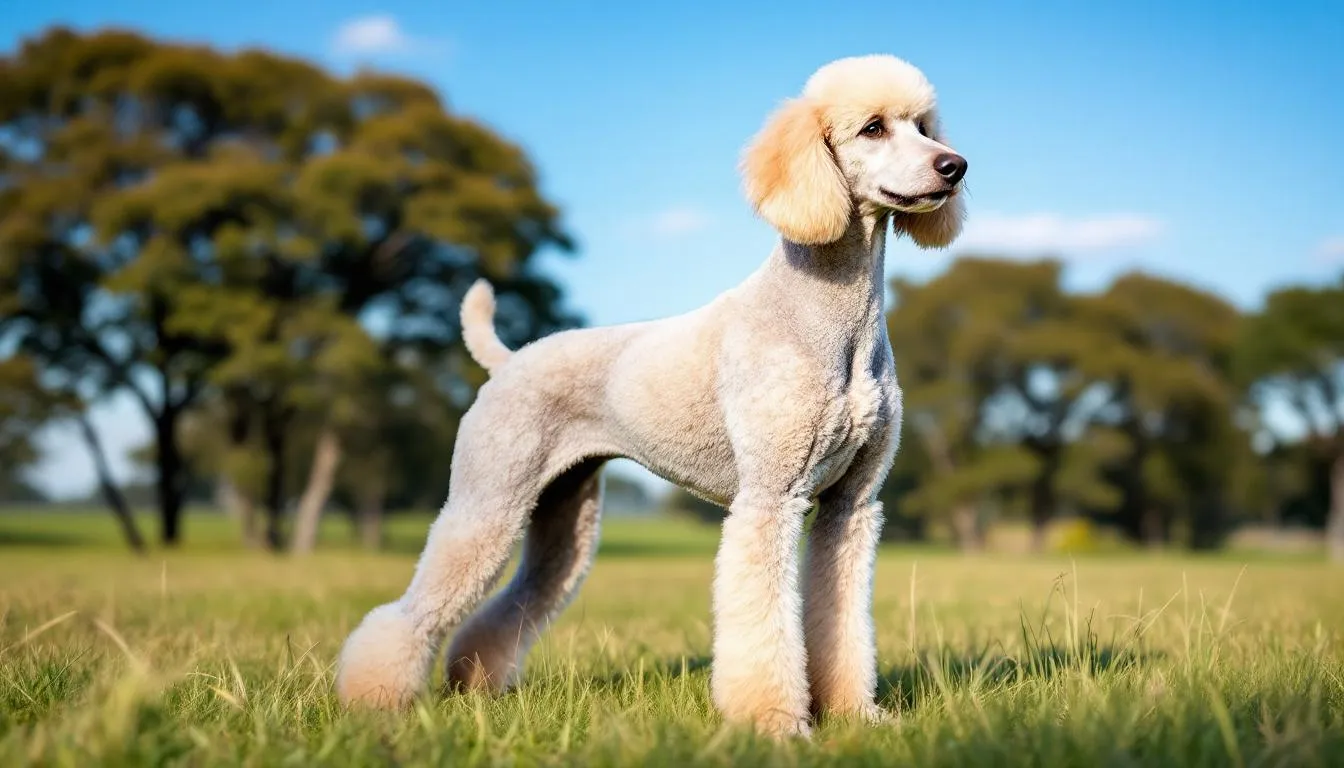

Key Takeaways
Standard Poodles are athletic, intelligent water dogs standing over 15 inches tall and weighing 40-70 pounds
- Standard Poodles are athletic, intelligent water dogs standing over 15 inches tall and weighing 40-70 pounds
- They require daily exercise (1-2 hours), mental stimulation, and professional grooming every 6-8 weeks
- These dogs are excellent family pets but need consistent training and socialization due to their high intelligence
- Common health concerns include hip dysplasia, bloat (GDV), epilepsy, and skin conditions like sebaceous adenitis
- Their hypoallergenic, curly coat requires daily brushing and significant grooming investment throughout their 10-18 year lifespan
They require daily exercise (1-2 hours), mental stimulation, and professional grooming every 6-8 weeks
These dogs are excellent family pets but need consistent training and socialization due to their high intelligence
Common health concerns include hip dysplasia, bloat (GDV), epilepsy, and skin conditions like sebaceous adenitis
Their hypoallergenic, curly coat requires daily brushing and significant grooming investment throughout their 10-18 year lifespan
You’re drawn to the Standard Poodle’s reputation for intelligence and athleticism, but wonder if this elegant dog fits your lifestyle. Beyond the show ring glamour lies a breed originally bred for serious work—retrieving waterfowl in cold German waters. These aren’t delicate companion dogs requiring kid-glove treatment. They’re robust athletes who need owners ready to match their energy and mental sharpness.
This guide covers everything from daily care realities to long-term health considerations. You’ll learn what makes Standard Poodles exceptional family members and why they demand more commitment than many other breeds. Let’s explore whether this remarkable dog breed aligns with your life.
What is a Standard Poodle?
The Standard Poodle stands as the largest and original variety among poodle sizes, towering over its miniature poodle and toy poodle relatives. Originally bred in Germany as hunting dogs, these water retrievers earned their name from the German word “Pudel,” meaning “to splash in water.” Despite their strong association with French culture, most authorities recognize Germany as their birthplace.
Standing over 15 inches tall at the shoulder, male Standard Poodles typically weigh 60-70 pounds while females range from 40-50 pounds. The American Kennel Club classifies them in the Non-Sporting Group, though their athletic heritage suggests otherwise. In France, where they’re considered the national dog, they’re known as “Caniche” or “duck dog”—a nod to their waterfowl hunting origins.
What sets Standard Poodles apart from other dogs isn’t just their impressive standard poodle’s size. Their athletic build, designed for swimming and retrieving, combines power with agility. Unlike many large breed dogs, they maintain elegance in their proportions, with a sleek frame that speaks to centuries of selective breeding for both function and form.
The breed’s intelligence ranks among the highest of all dog breeds, making them both delightful and challenging companions. They’re independent thinkers who enjoy problem-solving, traits that served them well as circus performers in the 19th century. This same intelligence makes them exceptional at dog sports and as companion dogs for active families.
Standard Poodle Breed History and Development
The Standard Poodle boasts a storied history that stretches back centuries, making it one of the most recognizable and versatile dog breeds in the world. Originally bred in Germany, the Standard Poodle was designed as a water dog, prized for its ability to retrieve game—especially waterfowl—from lakes and rivers. The breed’s signature curly coat wasn’t just for show; it provided essential protection against cold water and harsh weather, allowing these dogs to work efficiently alongside hunters.
As the breed gained popularity, its intelligence and trainability led to the development of smaller varieties, including the Miniature and Toy Poodles. While the Standard Poodle continued to excel as a working and hunting dog, Toy Poodles found fame as beloved companions and even as circus performers, thanks to their quick learning and charming personalities. The breed’s adaptability and elegance soon caught the attention of dog lovers across Europe, and the Poodle became a favorite in royal courts and among artists.
The American Kennel Club officially recognized the Standard Poodle in 1887, cementing its status as a distinct and celebrated breed. Today, Standard Poodles are admired not only for their performance in dog shows but also for their roles as loyal family pets and versatile companions. Whether in the show ring, as working dogs, or simply as cherished pets, Poodles of all sizes continue to impress with their intelligence, athleticism, and iconic curly coats.
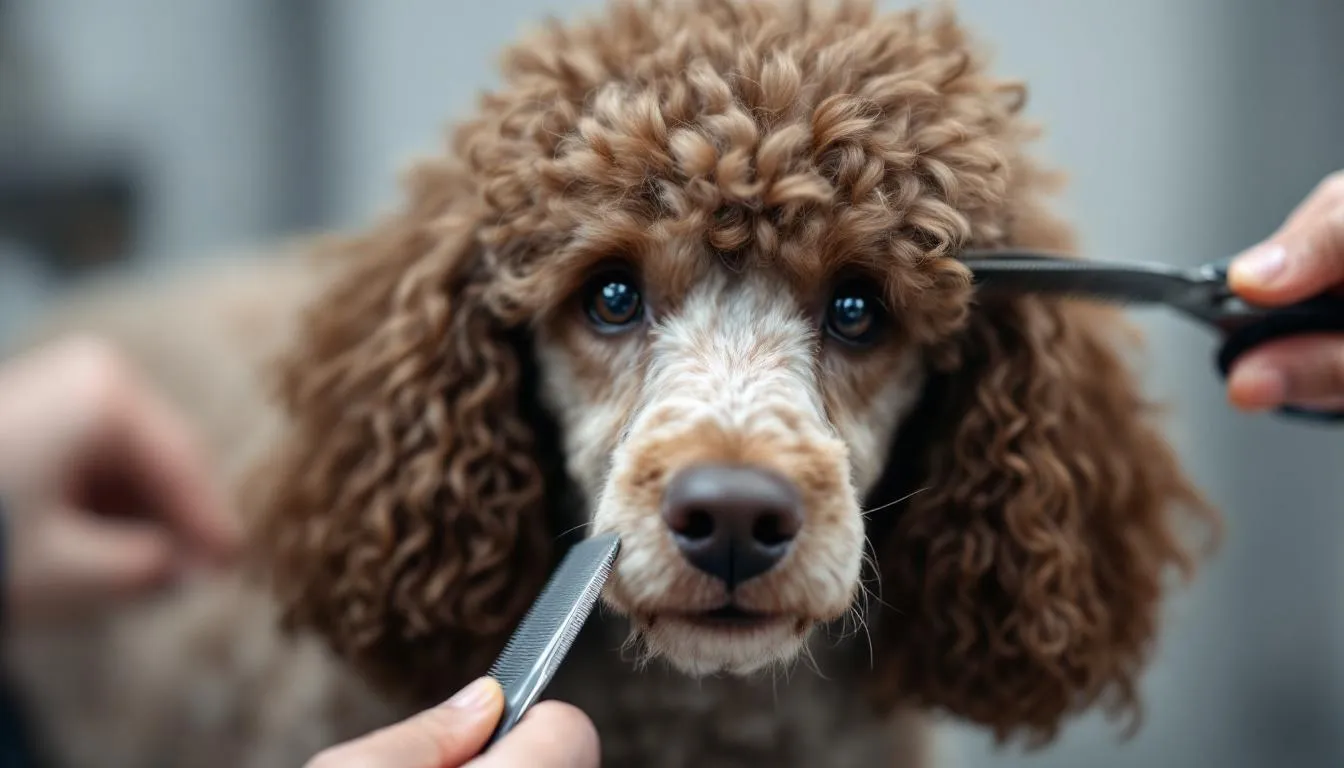

Standard Poodle Dog Appearance and Characteristics
A Standard Poodle’s most striking feature is undoubtedly their curly coat. This thick, textured coat forms natural cords if left untrimmed, creating the water-resistant barrier that made them invaluable to hunters. Poodle coats require regular grooming—daily brushing prevents matting, while professional grooming every 6-8 weeks maintains both health and appearance.
The American Kennel Club recognizes eleven solid coat colors, including classic black and white, rich browns, striking reds, and elegant silvers. Some Standard Poodles sport the rare silver beige coloring, while parti-color patterns add visual interest. Poodle coats come in many colours and patterns, though only solid colours are officially recognized by breed standards. Each individual dog’s coat may vary slightly in texture and curl pattern, but all share the breed’s characteristic low-shedding properties.
Height ranges from 18-24 inches, though some sources note specimens reaching 27 inches. Their dark eyes convey intelligence and alertness, with slight color variations based on coat color. The high-set tail, often docked to meet breed standard requirements, adds to their distinguished silhouette.
The standard poodle’s coat isn’t just beautiful—it’s functional. Those curly locks trap dander and loose hair, making them suitable for many allergy sufferers. However, this same feature means debris, burrs, and moisture can become trapped, requiring vigilant grooming attention to maintain healthy poodle coats.
Their athletic build reflects generations of breeding for water work. Deep chested dogs like Standard Poodles can cover significant distances in water, their powerful hindquarters providing propulsion while their webbed feet aid in swimming. This same build makes them naturals at playing fetch and other high-energy activities.
Breed Standard and Conformation Including Miniature Poodles
The Standard Poodle’s breed standard, as outlined by the American Kennel Club, highlights the qualities that make this breed both beautiful and functional. A hallmark of the Standard Poodle is its dense, curly coat, which should be both water-resistant and non-shedding. This coat comes in a variety of accepted colors, including black, white, silver, and apricot, and requires regular professional grooming to maintain its health and appearance.
In terms of conformation, the ideal Standard Poodle presents an athletic, well-balanced silhouette. The breed standard calls for a deep chest, well-sprung ribs, and a level topline, all contributing to the dog’s powerful yet graceful movement. The Standard Poodle’s expression should be alert and intelligent, reflecting its keen mind and lively personality.
Professional grooming is not just about aesthetics—it’s essential for preventing matting and keeping the coat in top condition. Regular grooming sessions help maintain the breed’s signature look and ensure the dog’s comfort and health. Adhering to the breed standard ensures that each Standard Poodle embodies the qualities that have made this breed a standout in both the show ring and as a companion.
Temperament and Personality
Standard Poodles combine intelligence with independence in ways that surprise many pet parents. They’re extremely intelligent, ranking consistently among the smartest breeds in canine intelligence tests. This intelligence manifests as problem-solving ability, quick learning of new tricks, and an almost human-like understanding of household routines.
Unlike some other breeds that live to please, Standard Poodles are confident decision-makers. They’re eager to please but maintain independence in their thinking. This can translate to a dog who learns commands quickly but may choose when to follow them based on their assessment of the situation.
With family members, they’re affectionate and loyal. Most Standard Poodles bond strongly with their household and can be protective when needed. They’re generally excellent with older children who understand how to interact respectfully with a large dog. Their size and enthusiasm might overwhelm very young children during play, making supervision important.
Proper socialization during puppyhood shapes their adult temperament significantly. Well-socialized Standard Poodles typically get along well with other pets, including cats and other dogs. However, their hunting heritage means they may show interest in small animals like squirrels or rabbits. When well-trained and well-socialized, a Standard Poodle can be a great dog for active families or individuals seeking a loyal companion.
Their adaptability surprises many owners. A properly exercised Standard Poodle can be calm and relaxed indoors, content to spend time with family. However, mental stimulation remains crucial—bored Standard Poodles may develop unwanted behaviors like excessive barking or destructive chewing.
Energy levels vary among individual dogs, but most require substantial daily exercise and engagement. Each individual dog may have unique personality traits and energy requirements, so it's important to assess your own dog's needs. They’re not the type of dog who’s content with short walks around the block. These are athletes who thrive with jobs to do and challenges to solve.
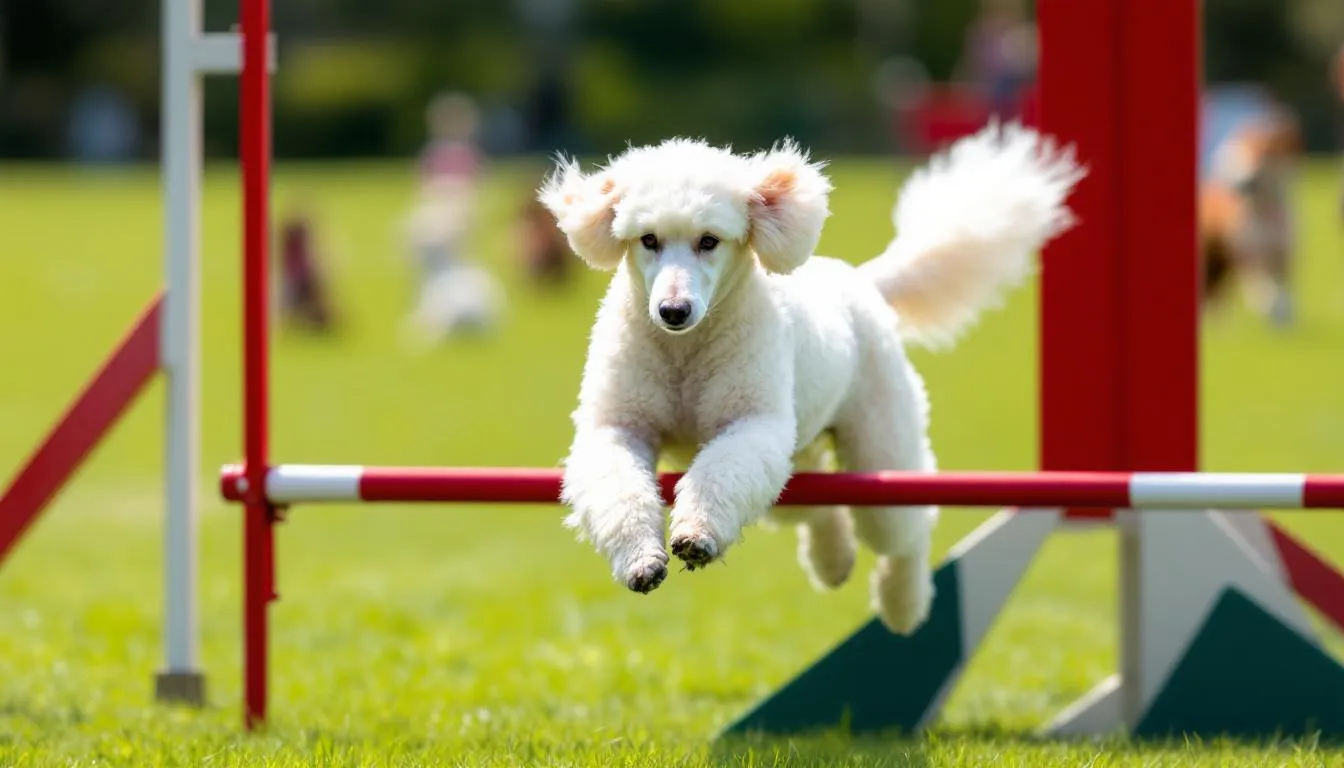

Exercise and Training Requirements
A tired Standard Poodle is a happy Standard Poodle. Plan for 1-2 hours of daily exercise, split into multiple sessions. Two brisk walks combined with fetch sessions or free running in a secure area typically meets their physical needs. Swimming, when available, provides excellent exercise that taps into their natural instincts.
Mental stimulation often matters more than physical exhaustion. Training sessions become both exercise and enrichment—teach them new tricks, practice obedience commands, or introduce puzzle toys. A few minutes of focused training while you’re making coffee counts toward their daily mental workout requirements.
Standard Poodles excel in dog sports, and participation benefits both dog and owner. Agility courses challenge their athleticism and problem-solving skills. Dock diving taps into their water-loving heritage. Rally and competitive obedience showcase their intelligence and trainability. Even if competition doesn’t appeal to you, these activities provide excellent bonding opportunities.
Early socialization proves crucial for confident adult dogs. Expose your new pup to various people, surfaces, sounds, and friendly dogs. Keep experiences positive and brief—let curiosity develop at your puppy’s pace. If your dog shows stress signals like freezing or turning away, respect those boundaries and provide space.
Training works best when kept short, clear, and rewarding. Mark desired behaviors immediately and reward generously. Standard Poodles respond well to positive reinforcement but may shut down with harsh corrections. Their intelligence means they quickly identify patterns, so consistency in commands and expectations prevents confusion.
Crate training provides benefits throughout their lives—for rest, travel, and vet visits. Make the crate a positive space with comfortable bedding, stuffed puzzle toys, and calm routines. Most Standard Poodles accept crate training readily when introduced properly.
Health Concerns and Lifespan
Standard Poodles enjoy a generally healthy life expectancy of 10-18 years, with proper care and genetics playing significant roles. Most poodles share common health issues and care requirements, such as the need for regular grooming and monitoring for breed-specific conditions. However, like all large breeds, they’re susceptible to certain health issues that responsible breeders screen for and pet parents should understand.
Hip dysplasia represents one of the most common concerns in Standard Poodles. This genetic condition causes loose joints, leading to inflammation and arthritis over time. Reputable breeders test breeding dogs for hip quality, but environmental factors like rapid growth and excessive exercise in young dogs can contribute to problems.
Gastric dilatation-volvulus, commonly called bloat, poses a serious risk for deep chested dogs like Standard Poodles. This life-threatening condition involves the stomach filling with gas and potentially twisting. Bloat can compromise blood flow to vital organs, making prompt veterinary attention critical. Prevention strategies include feeding smaller, frequent meals instead of one large meal, using slow-feeder bowls, and restricting exercise immediately before and after eating.
Idiopathic epilepsy affects some Standard Poodles, typically appearing between 2-5 years of age. While seizures can be frightening to witness, many dogs with epilepsy live normal lives with proper veterinary management. DNA testing can identify carriers of certain seizure-related genes.
Von Willebrand disease, a blood-clotting disorder, occurs occasionally in the breed. A simple DNA test can determine if your dog carries this condition, which helps in emergency medical planning and breeding decisions.
Sebaceous adenitis, an autoimmune skin disease affecting oil glands, appears more frequently in Standard Poodles than in other breeds. This condition can cause coat loss, skin irritation, and requires ongoing management. Early detection and treatment help maintain quality of life.
Regular wellness checks with your veterinarian, staying current on vaccines, and maintaining appropriate parasite prevention for your area form the foundation of good health care. Pet insurance can help manage costs if health issues develop, making it worth considering for Standard Poodle ownership.
Comparison to Miniature and Toy Poodles
While Standard, Miniature, and Toy Poodles all belong to the same breed and share the same breed standard, there are notable differences that set them apart. The most obvious distinction is size: Standard Poodles stand over 15 inches tall at the shoulder, Miniature Poodles measure between 11 and 14 inches, and Toy Poodles are under 10 inches tall. This range in poodle sizes allows families to choose the best fit for their living conditions and lifestyle.
Beyond size, Miniature and Toy Poodles tend to have a more delicate build and may display a slightly different coat texture compared to their larger relatives. However, all poodles are known for their intelligence, affectionate nature, and hypoallergenic curly coats. Regardless of size, poodles excel as loyal companions, quick learners, and adaptable pets.
When deciding between a Standard Poodle, Miniature Poodle, or Toy Poodle, consider your home environment, the amount of time you can dedicate to grooming, and your activity level. Standard Poodles often thrive in active households with space to play, while Miniature and Toy Poodles can be a great fit for smaller homes or those seeking a little guy with a big personality. No matter the size, all poodles require regular grooming and mental stimulation to stay happy and healthy.
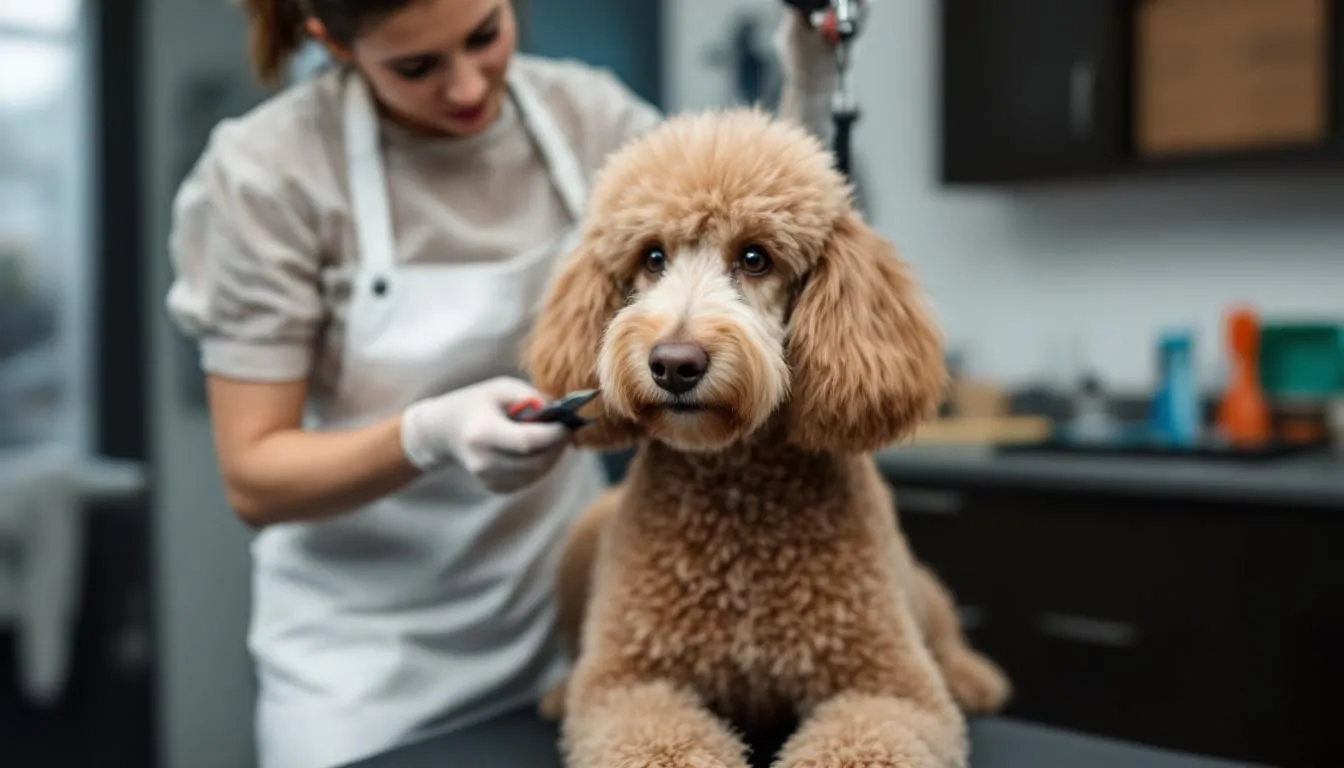

Grooming Requirements
The Standard Poodle’s magnificent curly coat demands significant grooming commitment. Daily brushing with a slicker brush prevents matting and removes debris before it becomes embedded. Work in sections to ensure you don’t miss areas behind ears, under legs, or around the collar where mats form quickly.
It is essential to groom Standard Poodles regularly to maintain their coat health and appearance. Professional grooming every 6-8 weeks maintains both health and appearance. Grooming costs for Standard Poodles often exceed $95-150 per session due to their size and coat complexity. Over a year, grooming expenses frequently surpass dog food costs, making this a significant budget consideration.
Monthly baths with dog-safe shampoo help maintain skin health and coat cleanliness. After baths, thorough drying prevents moisture from being trapped against the skin, which can lead to yeast or bacterial problems. Pay particular attention to ears, which can retain moisture and develop infections.
Traditional poodle clips include the Continental and Sporting styles seen in dog shows. However, many pet parents opt for shorter, more practical cuts that still showcase the breed’s elegance while reducing daily maintenance. Discuss options with your groomer to find a style that suits your lifestyle.
Home grooming is possible with proper equipment and training. A quality clipper set, various blade sizes, scissors, and slicker brushes represent the basic toolkit. Many Standard Poodle owners learn to maintain their dog’s feet, face, and sanitary areas between professional appointments.
The breed’s grooming needs extend beyond coat care. Regular nail trims keep feet healthy and protect your floors. Dental care, including brushing and dental disease prevention, maintains oral health. Ear cleaning helps prevent infections, especially important for dogs who swim regularly.
Feeding and Nutrition
Standard Poodles require complete nutrition formulated for large breeds, with specific attention to their active lifestyle and potential health concerns. Active dogs benefit from sport-type diets with increased caloric density, while less active dogs need carefully managed portions to prevent weight gain.
Feed twice daily using slow feeder bowls or puzzle feeders to reduce bloat risk. Avoid elevated feeding bowls, which some studies suggest may increase bloat risk in deep chested dogs. Measure meals with a scoop rather than guessing—consistency in portions helps maintain ideal body condition.
The amount varies based on weight, age, activity level, and individual metabolism. Most Standard Poodles thrive on 2-4 cups of high-quality dry dog food daily, divided between meals. However, feeding guidelines on packages provide starting points—your individual dog’s needs may differ significantly.
Fresh water should always be available. When changing foods, take five to seven days to gradually transition, mixing increasing amounts of new food with decreasing amounts of the old. Watch for changes in stool quality, energy levels, and coat condition during any dietary transitions.
Joint supplements containing glucosamine and chondroitin may benefit Standard Poodles, particularly as they age. Discuss supplementation with your veterinarian, especially if your dog shows early signs of joint stiffness or has a family history of hip dysplasia.
Avoid human foods and table scraps, which can upset digestion and contribute to begging behaviors. Some human foods are toxic to dogs, while others simply provide empty calories that can lead to weight gain. Stick to dog-appropriate treats and use them judiciously during training.
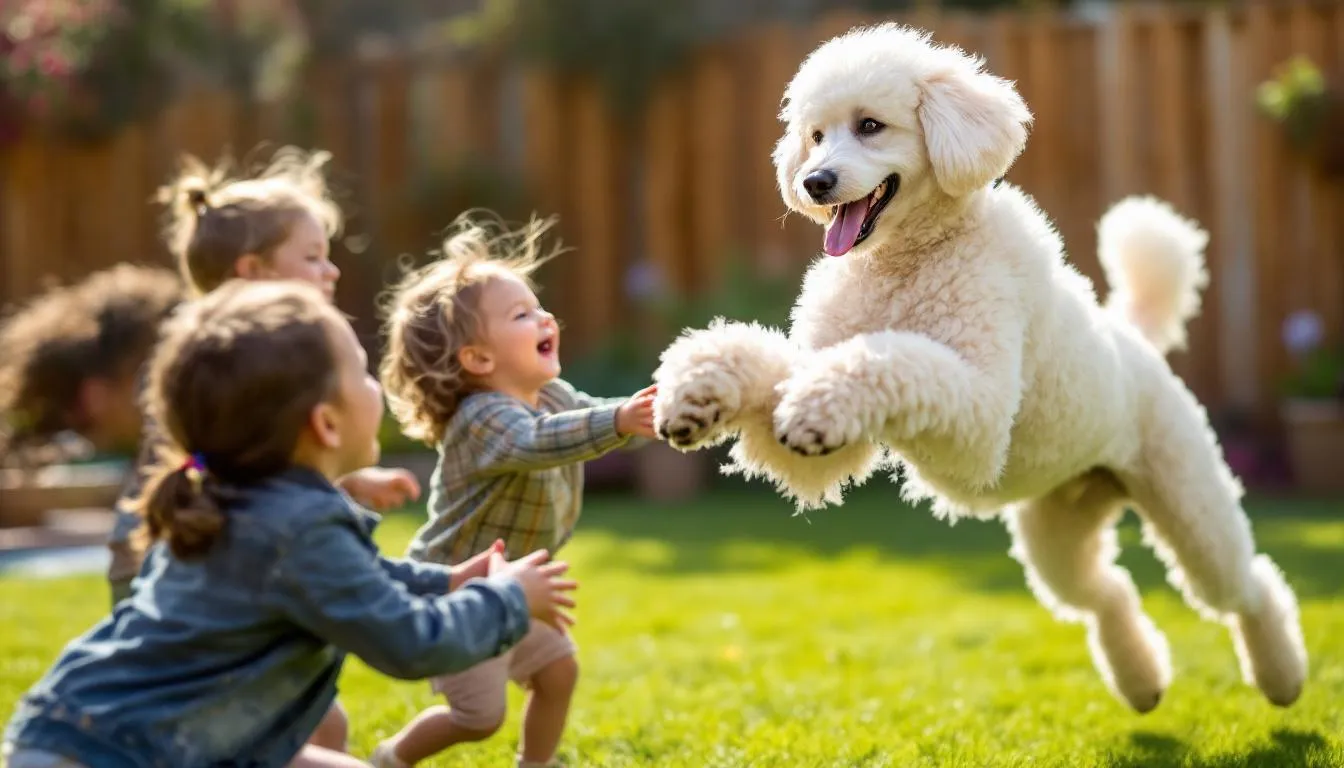

Living with a Standard Poodle
Standard Poodles thrive in homes with active families, particularly those with older children who can participate in training and exercise routines. Their size and enthusiasm may overwhelm very small children, but they generally adapt well to family life when given proper outlets for their energy.
Living conditions matter less than lifestyle commitment. While they appreciate yard space, Standard Poodles can adapt to apartment living if their exercise and mental stimulation needs are met consistently. However, their grooming requirements and exercise needs make them better suited to owners who can dedicate significant time to their care. Responsible dog ownership involves daily exercise, regular grooming, and ongoing training to ensure the dog's health and well-being.
Consider their interactions with other pets carefully. Most Standard Poodles get along well with other dogs when properly socialized, but their size and play style may be too overwhelming for small dogs. Always supervise interactions between your Standard Poodle and smaller pets until you’re confident in their relationship dynamics. Supervision is especially important when introducing a Standard Poodle to a younger one, such as a puppy or young child, to ensure safe and positive interactions.
The monthly grooming commitment and daily brushing represent significant time investments that continue throughout their 10-18 year lifespan. Add in daily exercise requirements, training sessions, and general care, and Standard Poodles require more hands-on attention than many other breeds.
Their intelligence makes them excellent candidates for families interested in advanced training, dog sports, or activities like therapy work. However, this same intelligence means they need consistent mental challenges to prevent boredom-related behaviors.
Standard Poodles often become deeply bonded with their families and may experience separation anxiety if left alone for extended periods regularly. They’re social dogs who prefer to be included in family activities rather than isolated in backyards.
National Breed Club and Rescue
For anyone interested in the Standard Poodle or its smaller relatives, the Poodle Club of America (PCA) serves as the national breed club and a valuable resource. The PCA is dedicated to promoting the breed, supporting responsible breeding practices, and providing education for both new and experienced poodle owners. Through the PCA, you can access information on training sessions, grooming tips, and the latest health research relevant to poodles.
The PCA also operates a rescue program, helping to rehome Standard Poodles and other poodles in need of a second chance. Many local breed clubs and rescue organizations work in partnership with the PCA, offering support networks, adoption opportunities, and community events. These groups are excellent sources of advice on everything from professional grooming to training and health care.
By connecting with the Poodle Club of America or a local breed club, you’ll join a passionate community dedicated to the well-being of this remarkable breed. Whether you’re seeking your first Standard Poodle or looking to expand your knowledge as a seasoned owner, these organizations provide the guidance and support needed for a rewarding journey in poodle ownership.
Finding a Standard Poodle
The AKC Marketplace provides listings of registered puppies from reputable breeders who follow ethical breeding practices. Look for breeders involved in performance activities or health testing—these indicators suggest commitment to producing healthy, well-tempered dogs rather than just meeting market demand.
When searching for a Standard Poodle, it is crucial to select a responsible breeder who prioritizes health, temperament, and adherence to breed standards. The breeder's dedication to these qualities greatly impacts the overall quality and suitability of your future pet or performance dog.
Research bloodlines for energy levels and temperament traits that match your lifestyle. Some lines emphasize show qualities, while others focus on working ability or sport performance. Meeting the parent dogs when possible gives insight into potential temperament and energy levels of puppies.
Over 450 AKC Rescue Network groups nationwide support Poodle rescue efforts. Adult Standard Poodles in rescue often come with known temperaments and may already have basic training. Rescue dogs can be excellent choices for families who prefer to skip the puppy phase challenges.
Breed clubs exist in every state, offering networking opportunities and support for new owners. These clubs often host educational events, training workshops, and social gatherings that benefit both dogs and owners. Members typically have extensive knowledge about local resources, from groomers to veterinarians experienced with the breed.
When evaluating breeders, ask about health testing of parent dogs, socialization practices for puppies, and their willingness to provide ongoing support. Reputable breeders often have waiting lists and will interview potential owners to ensure good matches between dogs and families.
Avoid puppy mills and pet stores, which rarely provide the health testing, socialization, and breeding ethics important for Standard Poodle puppies. While teacup poodle varieties may be advertised, these are not recognized sizes and often come with additional health concerns due to extreme miniaturization.
FAQ
Do Standard Poodles have a doggy smell?
No, properly groomed Standard Poodles typically don’t have the oily coat or strong odor common in many breeds. Their single-layer coat doesn’t trap oils like double-coated breeds. A smelly Standard Poodle usually indicates grooming neglect, skin issues, or ear infections requiring veterinary attention.
Can Standard Poodles live with small dogs safely?
With proper training and supervision, yes, but their size and enthusiastic play style can accidentally harm small dogs or cats. Consider each individual dog’s temperament and energy level. Always supervise interactions between Standard Poodles and significantly smaller pets, and provide separate spaces when unsupervised.
How much does Standard Poodle grooming cost annually?
Professional grooming every 6-8 weeks at $95-150 per session typically costs $600-1,200+ annually, often exceeding food costs. This doesn’t include daily brushing time or occasional nail trims. Home grooming requires equipment investment but can reduce long-term expenses for dedicated owners.
Are Standard Poodles truly hypoallergenic?
While no dog is completely hypoallergenic, Standard Poodles’ low-shedding, curly coat produces less airborne dander than many breeds. Their coat structure traps loose hair and dander rather than releasing it into the environment. However, individual allergy sufferers should spend time with Standard Poodles before committing to ownership.
What’s the difference between show and performance line Standard Poodles?
Performance lines may have higher energy and stronger drive for activities like hunting, agility, and water sports. Show lines focus more on breed standard conformation and may have slightly calmer temperaments. Both types require substantial exercise and mental stimulation—the difference lies more in intensity and focus than basic care requirements.
How do Standard Poodles compare to golden retrievers as family pets?
Standard Poodles and golden retrievers are both friendly, sociable breeds well-suited for families. Golden retrievers are known for their affectionate nature, high energy, and adaptability with children and small animals. They have a moderate grooming requirement and a distinct "doggy smell" due to their double coat. Standard Poodles, in contrast, have a low-shedding, single-layer coat with less odor and require regular grooming. Both breeds are intelligent and trainable, but Poodles may have a stronger off-switch with proper training. Both make excellent family companions with the right care and socialization.
FAQ
Do Standard Poodles have a doggy smell?
No, properly groomed Standard Poodles typically don’t have the oily coat or strong odor common in many breeds. Their single-layer coat doesn’t trap oils like double-coated breeds. A smelly Standard Poodle usually indicates grooming neglect, skin issues, or ear infections requiring veterinary attention.
Can Standard Poodles live with small dogs safely?
With proper training and supervision, yes, but their size and enthusiastic play style can accidentally harm small dogs or cats. Consider each individual dog’s temperament and energy level. Always supervise interactions between Standard Poodles and significantly smaller pets, and provide separate spaces when unsupervised.
How much does Standard Poodle grooming cost annually?
Professional grooming every 6-8 weeks at $95-150 per session typically costs $600-1,200+ annually, often exceeding food costs. This doesn’t include daily brushing time or occasional nail trims. Home grooming requires equipment investment but can reduce long-term expenses for dedicated owners.
Are Standard Poodles truly hypoallergenic?
While no dog is completely hypoallergenic, Standard Poodles’ low-shedding, curly coat produces less airborne dander than many breeds. Their coat structure traps loose hair and dander rather than releasing it into the environment. However, individual allergy sufferers should spend time with Standard Poodles before committing to ownership.
What’s the difference between show and performance line Standard Poodles?
Performance lines may have higher energy and stronger drive for activities like hunting, agility, and water sports. Show lines focus more on breed standard conformation and may have slightly calmer temperaments. Both types require substantial exercise and mental stimulation—the difference lies more in intensity and focus than basic care requirements.
How do Standard Poodles compare to golden retrievers as family pets?
Standard Poodles and golden retrievers are both friendly, sociable breeds well-suited for families. Golden retrievers are known for their affectionate nature, high energy, and adaptability with children and small animals. They have a moderate grooming requirement and a distinct "doggy smell" due to their double coat. Standard Poodles, in contrast, have a low-shedding, single-layer coat with less odor and require regular grooming. Both breeds are intelligent and trainable, but Poodles may have a stronger off-switch with proper training. Both make excellent family companions with the right care and socialization.






